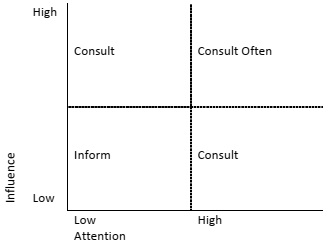Assignment Problem:
1) Who are the people who need to know about your change? What are the likely concerns for each group?
2) How are you going to ensure they understand it?
3) What are the key points you need each group of people to know/understand?
4) How will you respond to them, to ensure you build a critical mass who support your change?
Stakeholder Analysis
A Stakeholder Analysis is a useful way to identify the people who need to know about the change and their likely concerns. The following is a brief guide to developing a Stakeholder Analysis, for a more detailed explanation, review the resources.
Step 1: Identify your Stakeholders
Use your guiding coalition to identify all those who can contribute to or are impacted by the change initiative. This can be achieved through a brainstorming activity. Cast your thoughts as widely as possible.
Step 2: Categorize your Stakeholders
It can be useful to categorize your Stakeholders according to Influence and Attention. What is the amount of influence that each stakeholder group has on the success of the change? What is the likely attention each stakeholder group has with regard to the change? You can then map each stakeholder group onto the Influence - Attention diagram (example below).

Fig: Mapping Influence and Attention
Communication Plan
Now that we have a better understanding of who our stakeholders are, we can develop a Communication Plan. The Communication Plan gives us a planned, structured approach to our communications and ensures that all the key stakeholders are consulted on their areas of interest and concern.
Key Messages
Consider the key messages that you want to reinforce in your communication. These will obviously be different for each change imitative.
Channel
It is important to consider multiple channels for communication. 'Change by Email' is rarely effective. Communication channels include: meetings; newsletters; project briefs; emails; teleconferences; video link; one-on-one; etc. Consider the channel that will be most useful for the audience and the message you are trying to convey.
We now have a better understanding of our stakeholders, the key messages we want to communicate, and the channels of communication available to us. We can now develop our Communication Plan.
The templates attached, or suitable alternatives may be utilized to complete this task.
Stakeholder Analysis and Management Plan Template
Definition of a 'stakeholder': A stakeholder is a person, group or organisation that affects or can be affected by the change and can be characterized by the following:
a) Will be impacted, positively or negatively by the change;
b) Are in a position to support or oppose the change;
c) Can influence the thinking or actions of other stakeholders involved in the change; or
d) Have the ability to impact the change effort directly or indirectly
Stakeholder Engagement - Research and Discuss
This assessment task requires researching and discussing the following:
a) Explain engagement models, benefits and applications
b) Compare forms and methods of stakeholder engagement
c) Utilize means, media and methods of communication
d) Document types and role of program stakeholders.
Your response should be specifically related to application of stakeholder management within the context of program management. Provide specific examples to support your discussion.
The report you produce should be no less than 2,000 words.